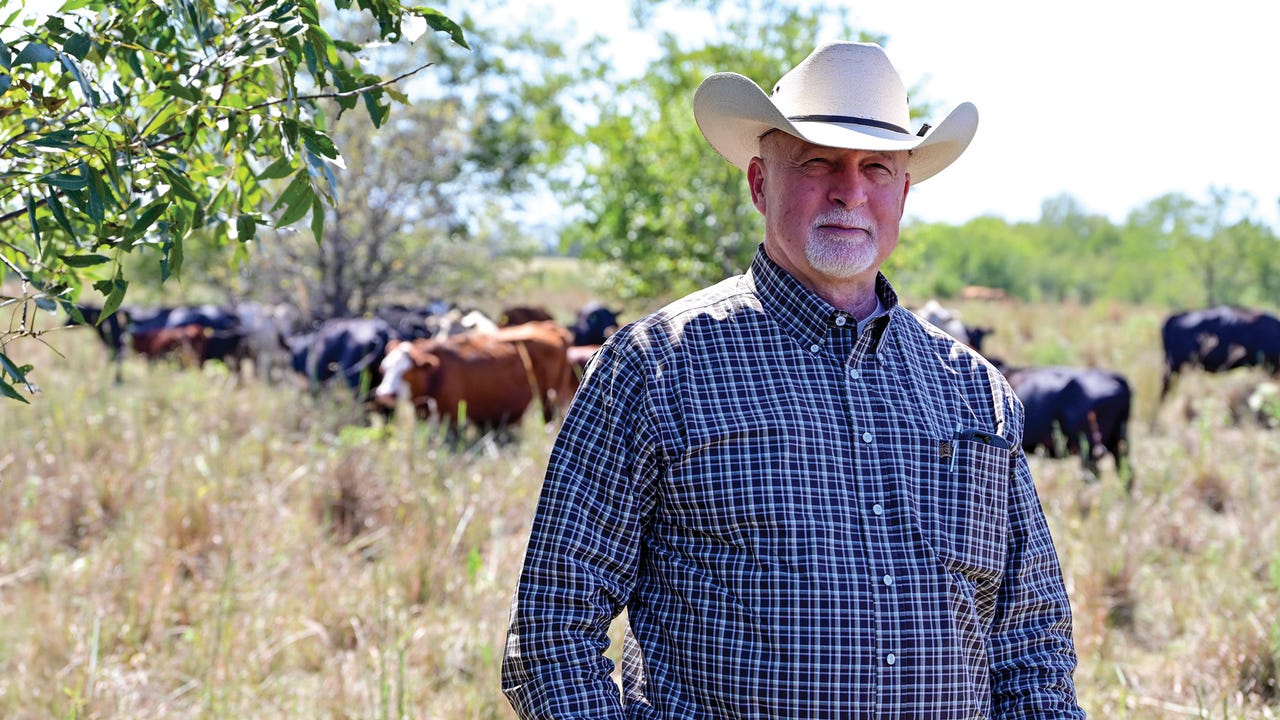At the north end of the country, Jared Knock cocks his head, smiles down at daughter Ansley, 10, and asks her which bird is singing in the tree near the pond. Perhaps, he says, the serenity of his South Dakota farm best underscores the impact of regenerative agriculture.
At the south end of the nation in Oklahoma, ranch director Hugh Aljoe drives the acreage at the Noble Research Institute, checking on the progress of reclaiming various stretches of pasture and rangeland.
“Everybody thinks it’s as ugly as sin. And it is,” Aljoe confesses. “Does it look like what we’ve always done? No. Does it look kind of messy? Well, yeah. But where there’s never been a black layer before, we’re starting to see color come in. The good soils always will improve faster. But even the marginal soils will improve in five to six years.”

Where a rancher once couldn’t make a profit, Aljoe and Noble are finding a way. Where a farmer couldn’t make a profit, Knock and AgSpire, a company that designs and implements sustainability programs for agriculture, are cutting a path to economic sustainability. Both companies are focused on keeping families on the farm.
“This is how we keep people on the land,” says Joe Pokay, Noble’s ranch manager, apologizing for his sermon-like response.
No matter, these ag leaders preach the same message: diversify crops and livestock, cut inputs, manage carefully — and turn a profit.
Noble leads by doing research and offering classes for practical application and business management. Steve Rhines, its president and CEO, came to the 70-year-old organization in 2019. Two years later, Noble moved into regenerative agriculture.
Noble’s goal is to bring 164 million acres of grassland into the program. That’s 25% of the land managed by U.S. livestock producers. When Noble developed its goals, Rhines recalls, “Someone had heard that the tipping point for change is 25%. That’s when it starts to snowball. That’s when we think we’ll have the momentum.”
To support farmers with the cost of implementing new practices, AgSpire uses an Extension-style approach. To fund such programs, it works with companies that buy commodities.
Knock says companies come to AgSpire with an interest in the environmental benefits of soil health, regenerative agriculture and biodiversity. Once they see the on-farm results of those practices, they sign on to help farmers go from implementation to a profitable practice.
“Sustainable practices on farm and ranch land are — just on its face — a worthy investment for these companies to do, even if they didn’t have carbon or anything as a priority,” Knock says. “Once these companies see the impact that they’re having on individual farms and ranches, people’s lives, the landscape, carbon really isn’t much of a factor anymore. They get excited about what their projects are doing.”
Riding a utility vehicle, Knock points out examples of sustainability practices on his farm. On one field, he shows marginal land around a soybean field. Where soybean yield once dropped off the map due to soil salinity, he now grows hay. Several years into the practice, he earns more from hay than the soybeans.
Focus on the practice
Startup cost justifies support, but Knock prefers to think of AgSpire as a company focused on the practices, which he sees as the path of economic stability for family farms.
“We’re about putting the practice in place,” he says. “Then the farmer decides how it works and whether it’s economically viable.”
Noble’s aim is the same. Staff at the 13,500-acre ranch study how to lower production costs to increase profit. Pokay offers three ways to increase profits:
- improve gross margin per unit
- increase turnover
- reduce overhead costs
“We sell our cattle at the sale barn just like every other rancher sells cattle at the sale barn,” Pokay says.
Noble also records costs and income the way it teaches ranchers. That’s how Pokay can confidently say: “Our cattle are more profitable now because we have lowered our input costs to raise them.”
The unquantifiable environmental benefits are the bonus. And Pokay and Knock take pride and enjoyment in the stewardship.
“I showcase this program right outside my driveway because it’s really enjoyable to look at,” Knock says. “Once you get that job in town and you have a little prosperity, one of the first things you do is you try to get yourself situated into a place where you like your immediate surroundings so well that you don’t want to go anywhere. … We can do that on a farm better than anywhere we can think of. But we just gotta get over the financial hump.”
That’s the path that Knock knows too well. Farming was his goal, even though every time he tried to drop out of college, his dad stopped him. Today, he and wife Kati are raising their three daughters on a once-dilapidated farm in the neighborhood where he grew up.
Essentially, Knock helped create a company focused on helping other families who share his dream of staying on the farm. For farmers looking down the trough of the ag economy cycle, he suspects the idea of diversifying to make marginal acres profitable is enticing.
To his fellow farmers, Knock says: “I think they should take a look at the input side of their business. Take a look at diversification of land use on certain acres. Take a hard look at expanding a livestock grazing enterprise in conjunction with the farming operation.”
Then he shrugs.
“But if you like where you’re at, then you’re fine,” he says, with a slightly wry smile. “If you’re not seeing any problems with the land, if you’re not seeing any problems with profitability, I mean, there’s no reason to change. It’s all about finding what’s right for you and your operation.”